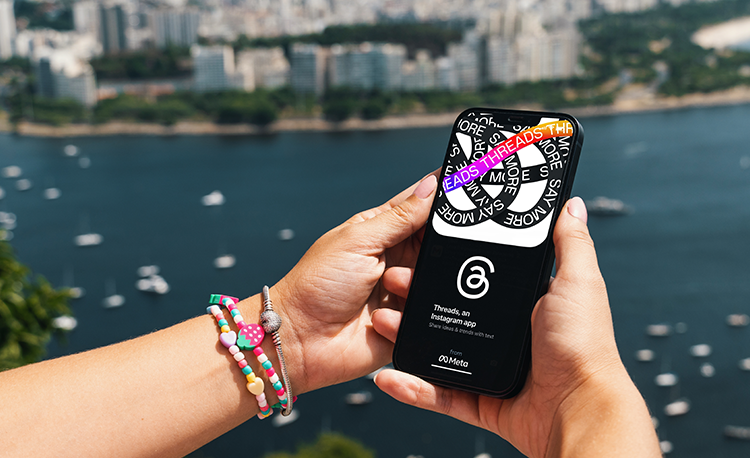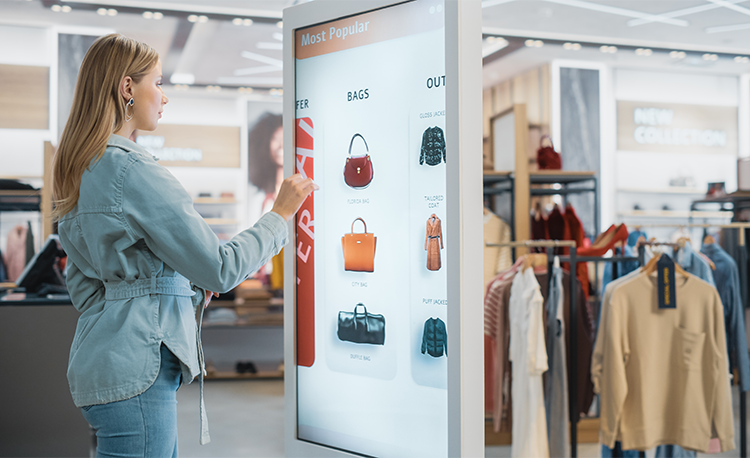Headless Commerce – The Next Tech Disruptor For eRetail Businesses
The Indian eCommerce industry is transforming at a faster pace than ever before with Indian…

It’s been a while since Meta introduced its contender to Twitter, a move that has reverberated across the social media landscape, leaving behind a trail of both positive and mixed takeaways. Within just 24 hours of its launch, the app amassed an impressive 30 million users, effectively disrupting the annals of social media history. This success owes a debt of gratitude to Instagram which has previously catalyzed the success of e-commerce brands. Thus, Threads, the new application from Instagram has raised the benchmark significantly capturing the keen interest of brands within the Direct-to-Consumer (D2C) realm.
However, is it really good? Does it genuinely deliver the intended advantages to brands? Or is it merely a passing fad, destined to be short-lived?
In the wake of its launch, these pivotal questions have occupied the thoughts of many. As a full-stack D2C enabler , we at the GH encountered a deluge of inquiries regarding our perspective on this novel platform’s functionality, potential benefits, and how it can be harnessed to gain an edge. In response to this surge of interest, our team undertook a comprehensive assessment of this platform, delving into its details to unearth the key insights that determine its potential value for D2C brands in the long haul.
In this article, we dissect the intricacies of Instagram Threads, shedding light on its positive, negative, and not-so-bad aspects for D2C brands.
When you start using Instagram Threads, at first glance, it might remind you of an early beta version of Twitter, albeit with a distinct focus on textual content. The textual orientation provides an avenue for D2C brands to express their opinions, manage online reputation, share new launches or existing product details, gauge sentiment within the social share, etc.
For instance, brands in the CPG and B&PC space where audiences are interested to read about product descriptions, ingredients, unique features, etc. may benefit from the platform more in the longer run as compared to other brands in the fashion and
lifestyle industry. Thus, the platform is more suited for brands that rely heavily on textual content and look for low-form factors for branding and conversion.
Additionally, the platform capitalizes on the power of free-flow API syndication through Facebook, Instagram, WhatsApp, and other platforms under the Meta umbrella. Such a syndication network offers D2C brands a broader reach and the ability to streamline their messaging across different platforms. However, its only MOAT compared to Twitter would be its syndication network power of free flow APIs.
The platform offers a streamlined set of functionalities allowing threads or posts to be up to 500 characters long supporting links, photos, and videos up to 5 minutes in length. With a capacity to include up to 10 media items, D2C brands can craft content that is informative, engaging, and conversion-altering.
Furthermore, Instagram Threads is accessible on both iOS and Android devices, Threads is currently available in more than 100 countries excluding the EU, making it more widely accessible for users. Adding to this, brands can also import their existing follower base ensuring a seamless transition and maintaining essential settings.
Instagram Threads introduces a compelling narrative for D2C brands i.e. intertwining identity and follower migration seamlessly. It means verified profile marks from Instagram seamlessly carry over, establishing brand authenticity and trust on Threads, regardless of participation in the Meta Verified Program. Meanwhile, brands can facilitate effortless follower migration, enabling brands to import their current base with usernames, names, and even block lists.
The migration safeguards engagement momentum, allowing D2C brand to nurture their community without starting afresh. These features empower brands to extend their credibility, while also necessitating content adaptation to Threads’ unique landscape and potentially diverse user demographics.
Even though the app launch was perfectly planned, it’s hard to see Threads as anything but a plagiarised attempt by Meta to return to its glory days. Though Instagram Threads offers a distinct approach to content and engagement, it’s necessary to consider or acknowledge the drawbacks and limitations that D2C brands might face once they start committing to the platform. For instance,
In the current digital era where visual content is holding immense influence, Instagram Threads taking a different approach by prioritizing textual content only. Unlike platforms such as Instagram and Facebook where images and videos are a core way of communication, Threads lean more towards written expressions. It can pose challenges for D2C brands that heavily rely on visual content to captivate and engage their audience. Industries such as Fashion and Lifestyle which often leverage eye-catching visuals to drive impulse-based shopping, might find it difficult to create the same level of urgency on Threads.
One of the major gaps in Instagram Threads’ arsenal is its limited advertising technology capabilities. Unlike more established platforms that offer advanced targeting, tracking, and customization for advertising, Instagram Threads fall short in this aspect. This limitation can restrict brands from fully utilizing the platform as a promotional tool. The absence of robust AdTech features might hinder brands from effectively reaching their target audience and measuring the success of their campaigns.
While Instagram Threads presents itself as an intriguing platform for D2C brands to explore, there are underlying shortcomings that might cast a shadow over the overall user experience and effectiveness of marketing strategies.
One of the unavoidable and critical aspects of Threads that can impact D2C brands is the absence of comprehensive performance metrics. Unlike well-established platforms that offer in-depth insights into post performance, engagement, reach, and audience behaviour, Threads falls short in this aspect. The lack of detailed metrics or analytics
can leave brands grappling with uncertainty about the impact of their existing content. Metrics such as shares, likes, comments and click-through rates serve as vital indicators of content performance, guiding brands in refining their strategies. Without such data, D2C brands might find it challenging to assess the resonance of their messages and adapt their approach for optimal results.
In the realm of social media, competition is fierce with each platform striving to provide a comprehensive platform user experience. In comparison to its rival app Twitter, Instagram Threads lacks certain features that have become standard expectations for users.
For instance, the absence of long video formats, direct message functionalities, live audio rooms, etc. limits the versatility of Threads as a communication platform. D2C brands who desire a range of engagement options on social media platforms might find Threads somewhat restrictive in meeting their needs.
One major point that needs to be considered inconvenient for D2C brands is the inability to delete a Threads Account once it has been activated. According to Meta’s ‘Supplemental Privacy Policy’ users who delete their threads account or profile will also be deactivating their Instagram account. Why?
Since both Threads and Instagram accounts are interlinked with each other, deleting Threads would simultaneously delete your Instagram account too! For brands that have invested time and resources in building their Instagram presence, this limitation can result in significant disruption. The lack of flexibility might deter some brands from fully embracing Threads especially if they have concerns about potential complications.

Beyond performance metrics, there is the absence of certain functionalities on Threads that can hinder the execution of well-rounded marketing campaigns. These functional gaps can prove to be obstacles for D2C brands looking to establish a holistic and engaging online presence. These missing elements are
The absence of a following feed diminishes the sense of connection and community that brands can foster with their audience. Unlike other platforms that offer chronological feeds of content from accounts followed, Threads lacks this feature, potentially limiting users’ ability to engage with brands in real time.
GIFs have become a staple of online communication, injecting touches of humour and visuals into interactions. The absence of GIF support on Threads restricts brands’ ability to add a dynamic and relatable element to their messaging, potentially impacting engagement.
We are humans. Brands are made of humans. And humans make mistakes. Thus mistakes happen and being able to edit posts is crucial to avoid mistakes. It’s an important feature for maintaining a polished and error-free online presence. Threads lacks post-editing capabilities which can be frustrating for brands that wish to rectify errors or update content after publishing.
Accessibility is a paramount consideration in modern digital marketing. The ability to add user-generated alternative image text hampers brands’ efforts to make their content inclusive and accessible to all users including those with visual impairments.
Hashtags play an impressive role in content discovery and exposure on social media. Unlike Instagram, the absence of a feature on Threads that redirects users to related content when clicking on hashtags limits brands’ ability to capitalize on trending topics and conversations.
Meta “Threads” app, poised as a Twitter contender, catching the D2C brand’s attention. It offers benefits depending on your type of brand and requirements. It’s good for
niches that use words a lot like Beauty or Food. Though the app has its extensions, limitations, or restrictions. For instance,
It is important to note that since its launch user engagement on Instagram Threads has plummeted by 80%. And our early assessments suggest that the established brands should hold on for now and not venture into the platform. We reckon that it would be limited to being a syndication platform as far as eComm/D2C/eRetail businesses are concerned where global/well-established brands can add it to their arsenal of customer touchpoints. For now, it largely remains a space to watch out for!
Ready to take your brand online? GreenHonchos can prove to be a growth partner for your brand. Helping kickstart, execute and manage the growth of over 200 leading D2C brands, GreenHonchos is a leading full-stack D2C enabler offering services like growth marketing, eCommerce digital marketing, marketplace management, social media marketing and much more! For more valuable insights on eCommerce marketing and D2C growth strategies, follow us LinkedIn, Facebook , Instagram , and Twitter or visit our website to know more about our services.


As Henry Ford wisely said, “The only real mistake is the ...


For many years, July was often considered a slow month for r...


With the overall increase in global retail sales figures, th...


In the...


In the...


The Indian eCommerce industry is transforming at a faster pa...


It’s been a while since Meta introduced its contender to T...


Marketing your brand at Amazon can exponentially boost your ...


The pandemic has brought about a lot of changes and ada...


There is no denying the fact that marketplaces have bee...


The post-pandemic world has made brands realise the importan...


We are living in a digital age where every brand is coming a...


Digital media accounted for 64.4% of global ad sp...


Marketers since generations have banked heavily on the ...


Social Media has grown rapidly in the past couple of years. ...


The first step towards building a successful business i...

Want to take your eCommerce business to the next level? We help businesses make the most at every stage - from product conceptualization to achieving the maximum optimization & ROI on business operations.
B-24, Sector 3, Noida, GB Nagar,
Uttar Pradesh 201301, India
Mazaya Business Avenue, Tower AA1,
FZCO, Office #18, 36th floor, JLT, Dubai, UAE
1st Floor, Plot-183, Indiranagar Stage 2,
Bengaluru, Karnataka,
560038, India